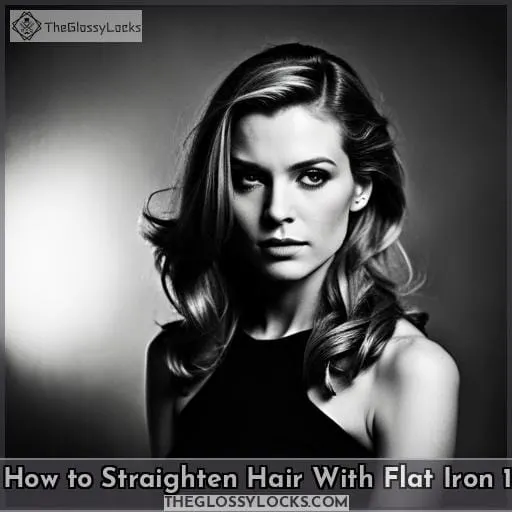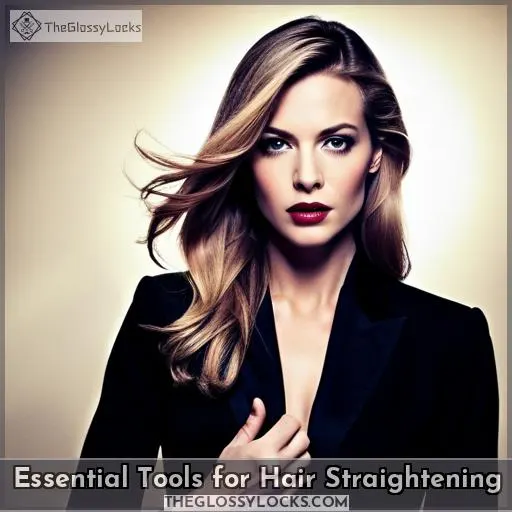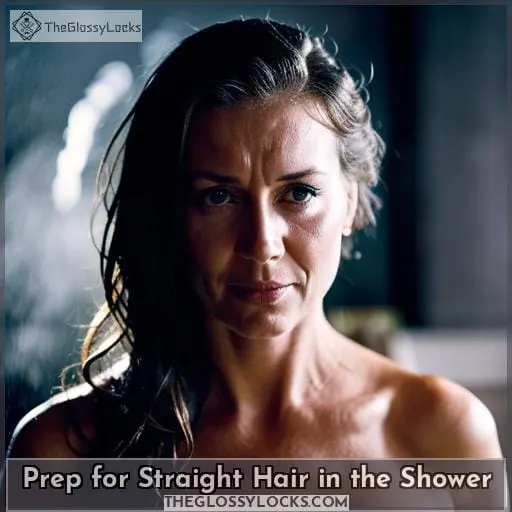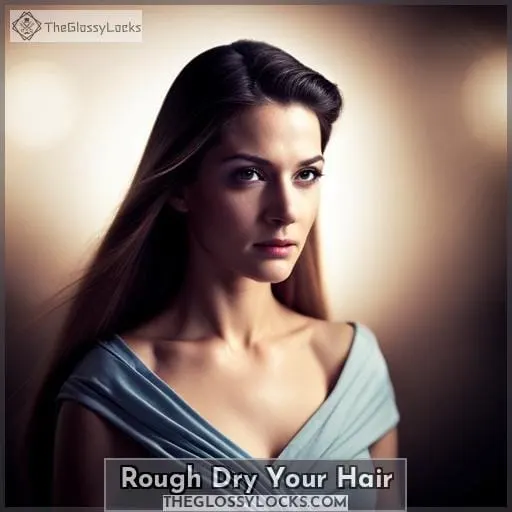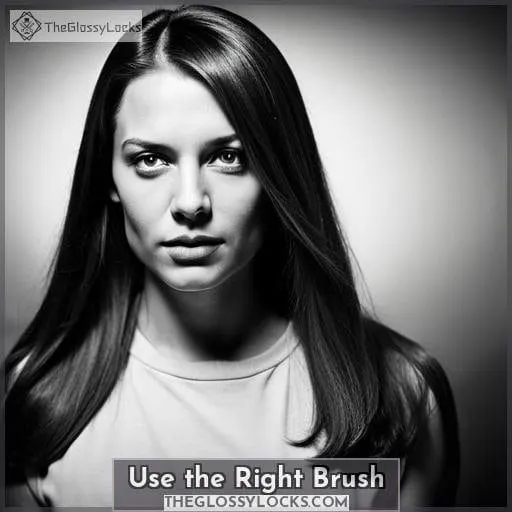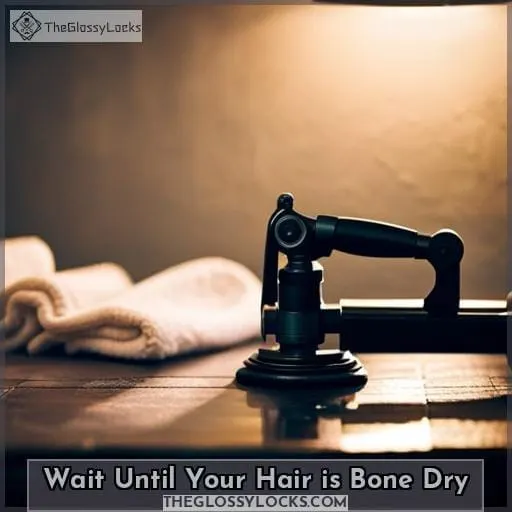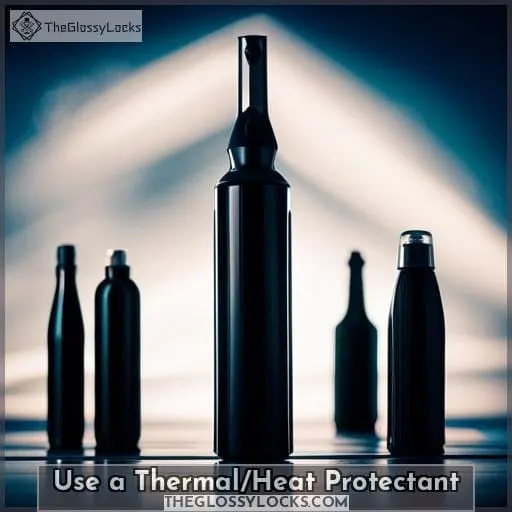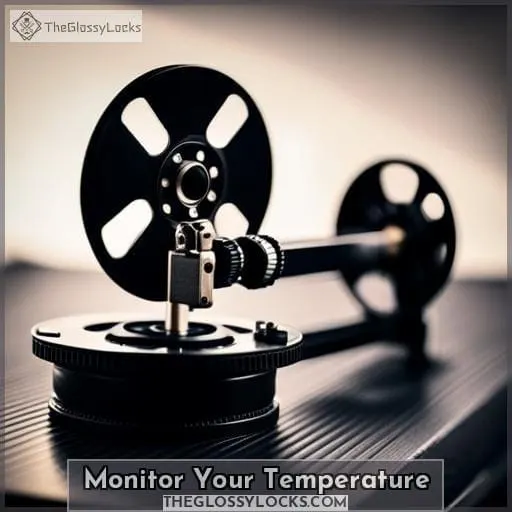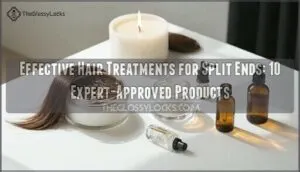This site is supported by our readers. We may earn a commission, at no cost to you, if you purchase through links.
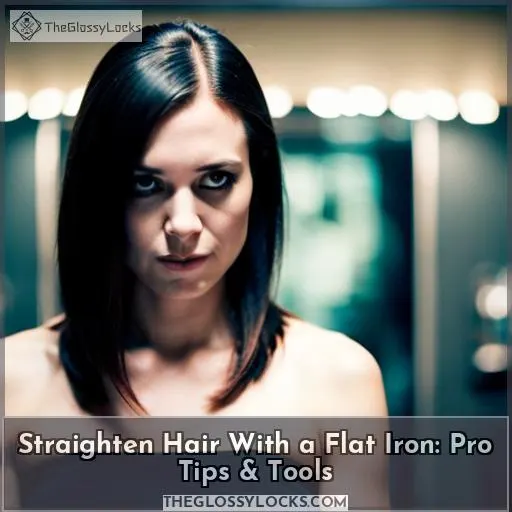 Do you dream of having sleek, straight hair like a professional? You can achieve it with the right flat iron and technique. To get started on your journey to beautiful long locks, you’ll need to know how to use the tool correctly.
Do you dream of having sleek, straight hair like a professional? You can achieve it with the right flat iron and technique. To get started on your journey to beautiful long locks, you’ll need to know how to use the tool correctly.
The process isn’t hard if done properly – here’s everything you need for success in straightening your hair with a flat iron. Before beginning this process, make sure that all tangles are removed from your dampened (not wet) hair.
Also, apply heat protectant products beforehand for an extra layer of protection against damage caused by high temperatures.
With these tips and tools at hand, learn how to confidently create salon-quality hairstyles!
Table Of Contents
- Key Takeaways
- How to Straighten Hair With a Flat Iron
- Essential Tools for Hair Straightening
- Prep for Straight Hair in the Shower
- Rough Dry Your Hair
- Use the Right Brush
- Wait Until Your Hair is Bone Dry
- Use a Thermal/Heat Protectant
- Monitor Your Temperature
- Take It One Section at a Time
- Frequently Asked Questions (FAQs)
- Conclusion
Key Takeaways
- Use the right technique and tools, such as a flat iron, to achieve sleek, straight hair.
- Prep your hair by removing tangles, applying heat protectant, and using quality products.
- Take small sections of hair and work from the back to the front, going against the natural grain.
- Use temperature control and heat protection to prevent damage and achieve the desired results.
How to Straighten Hair With a Flat Iron
Getting your hair straightened with a flat iron can be intimidating, but it doesn’t have to be daunting. To begin with the right foot, make sure you start off by getting your hair clean and free of product buildup.
Comb it out thoroughly so that the heat from the flat iron will distribute evenly throughout each strand.
Always start at the back of your head and work inwards towards your face. This is because you should always go against the natural grain when styling with heat tools! Additionally, take small sections not wider than an inch for maximum control, as well as even distribution when applying heat directly on strands.
Get the Start Right
Getting the start right is key to achieving sleek, shiny hair without damage. Cleanse with a paddle brush and microfiber towel, then rough dry locks at 80%. Use a boar bristle-nylon mix for extra polish. Heat protection, like Living Proof’s Straight Spray, keeps hair safe from heat damage, while temperature control helps avoid further harm to fine/damaged strands.
Clean It to Maintain It
To achieve sleek strands that last, it’s important to maintain the cleanliness of your hair before and after you style. Start with clean products like heat protectants, such as Living Proof’s Straight Spray, that reduce frizz while keeping your locks safe from damage.
Keep temperature control in check by using ceramic plates at a maximum of 350 degrees for fine or damaged hair. When sectioning, use a brush like boar bristle-nylon mix to ensure all strands are properly conditioned before straightening them with a flat iron or hair straightener.
With these tips, you’ll be able to enjoy sleek tresses for longer without damaging them!
Comb It Right
Combing your hair the right way is key to achieving a smooth, glossy finish when styling with a flat iron. Selecting the appropriate brush and sectioning method can prevent product buildup and frizz while protecting from heat damage.
Opt for a traditional terrycloth towel or microfiber DevaTowel to dry before rough drying with a blow dryer at 80% level. Use a boar bristle-nylon mix brush on each strand prior to straightening and keep temperature control in check by using ceramic plates no higher than 350 degrees for fine/damaged hair.
Always Start Backwards
Always start by brushing your locks backwards when prepping for a smooth, glossy finish. Use a boar bristle and nylon mix brush to gently detangle the hair before straightening with a flat iron.
When sectioning the hair, make sure to use no more than one-inch sections of hair and avoid applying high heat as it can cause damage.
Finally, ensure you’re setting your straightener at low temperatures (300-350 degrees) to maintain shiny strands that are free from breakage or split ends.
One Inch at a Time
When styling your hair, take small sections, no wider than an inch, to ensure that the flat iron can reach all of your strands and prevent overapplication of heat.
To achieve long-lasting straight hair with minimal risk for heat damage or frizz, choose a safe temperature setting on the flat iron. Use a quality brush to detangle tresses and prep with a product designed for sleekness.
For added protection against breakage and split ends, opt for a low temperature range (300-350 degrees).
Essential Tools for Hair Straightening
Getting your hair perfectly straight starts with the right tools. To achieve salon-worthy results, you’ll need a quality flat iron, clips to section off areas of your head for easy styling, and brushing out each section separately afterwards.
You’ll also need a brush specifically designed for detangling wet or dry hair, a good blow dryer that won’t overheat and damage your strands, as well as rollers if you want an extra smooth finish.
Hair Iron
You’ll need a hair iron that is suitable for your specific type of hair in order to achieve the best results. Pay attention to the heat level and temperature control so you don’t damage or burn your locks.
When selecting an iron, look for one with adjustable settings so you can adjust it according to different sections of the hair.
To prevent frizziness, make sure not only that it is clean but also heated correctly before using on each section. A hairstyle tool like this should be used carefully; incorrect use may cause an undesired shape of the hair or even breakage due to its high temperatures.
Use small sections at a time when straightening and keep track of every step along the way until achieving the desired style!
Clips for Sectioning
Separating your hair into sections with clips is key to achieving a sleek, polished look without overworking any one area. Heat protection and sectioning tips are essential for successful hair straightening.
When using a flat iron, remember to use the right brush when drying and brushing; this will help avoid heat damage.
Follow guidelines on how best to dry your favorite hair type while taking extra care of already damaged strands.
Above all else, never forget to invest in quality tools that protect against unnecessary breakage or split ends – it’s worth every penny!
Hair Brush
Investing in the right brush is essential for achieving smooth, polished strands and avoiding heat damage. Conditioning brushes with boar bristles are ideal for taming frizz without damaging your hair.
Heat protection sprays like Living Proof’s Straight Spray should be used before any flat iron use to protect color-treated hair from breakage or split ends.
Regular users of a hair straightener often swear by Stylist Sarah Potempa’s brushes.
Paddle brushes can detangle wet locks while also smoothing out dry or styled manes when combined with a blowdryer – all without compromising volume!
Invest in quality tools that support your styling needs, but never forget about protecting already damaged strands too – it’s worth every penny!
Hair Dryer
Achieve a sleek, professional look by using a quality hair dryer on your locks — it’s the perfect prep step to help keep frizz at bay!
Hair dryers come with various functions and settings that can be used depending on one’s curls vs.
For coarser or thicker manes, try blow-drying at low-medium temperatures instead of the high heat setting like the 450-degree option.
While those with finer tresses should stick to lower settings for the best results.
To reduce damage from heat styling, always use an effective thermal protectant prior to drying & straightening for optimal results in controlling frizz without compromising volume!
Flat Rollers
For an extra polished look, consider using flat rollers to wrap your strands around for a few minutes before you begin straightening. In fact, many stylists suggest that doing this can reduce the amount of time needed to heat style by up to 40%.
To ensure proper protection from heat damage with blow drying tips and temperature control, use brands like Living Proof’s Straight Spray. Use a boar bristle and nylon mix brush when sectioning technique comes into play as it helps smooth and polish hair.
When selecting an iron clamp, be sure it is within the safe temperature zone of 300-350 degrees for fine or damaged hair before beginning prep work.
Prep for Straight Hair in the Shower
Getting your hair ready for a sleek style starts in the shower! Conditioning products and microfiber towels can help prepare each precious piece of hair, while heat protectants like Living Proof’s Straight Spray will keep it safe from damage.
Brushing techniques with boar bristle and nylon mix brushes are key to getting better results. Sectioning off areas of your head is also important for different styles, as this allows you to ensure that all strands get straightened evenly.
Taking advantage of the benefits of these tools will make sure that you achieve long-lasting results without overworking or damaging your mane.
Rough Dry Your Hair
Rough drying your locks with a blowdryer until it’s around 80% dry will help you reach the sleek finish you crave. Keeping the nozzle facing downwards can help avoid frizz, and using thermal/heat protection, such as Living Proof’s Straight Spray, is key to protecting your hair from damage.
With different varieties of paddle brushes available for varying textures of hair, this tool can be used to not only reduce frizz but also section off areas of the head for easier styling.
To stay safe in terms of temperature when straightening your mane, make sure that fine or damaged strands don’t exceed 350 degrees Fahrenheit – known as the safe zone among stylists! This technical term prevents heat-related damage while still allowing enough heat to achieve long-lasting results without overworking or damaging each precious piece of hair.
Have fun and experiment with different looks – when done right, it’ll leave you feeling liberated and powerful!
Use the Right Brush
Combining a boar bristle and nylon mix brush with your blow dryer can help smooth and polish the hair, giving you an effortlessly sleek look. Heat protectant products are also important for protecting your hair from damage while reducing frizz.
As a product of modern times, many kits come pre-packaged to help make the process easier too.
No matter which brand or variety of brush you choose – whether it’s natural bristles or synthetic material – one important factor remains: always be gentle on your locks! Healthy tresses go hand in hand with achieving great styles like straightening – something that should never be overlooked!
With careful preparation and attention to detail, there’s no reason why anyone shouldn’t get salon-worthy results at home without breaking the bank!
Wait Until Your Hair is Bone Dry
When it comes to achieving sleek, straight strands with your flat iron, timing is everything. Before you begin the straightening process, make sure that your hair is bone dry. Using a blowdryer on medium heat works best for this step. If dampness still remains in the strands when heat-styling, it could cause breakage or damage due to sudden changes in temperature and moisture levels unbalancing from each other.
Taking extra precautions, such as using a thermal/heat protectant like Living Proof’s Straight Spray, can help ensure that all coats are protected before beginning any further styling steps! Additionally, plastic brushes should be avoided at all costs as they tend to snag on hairs more easily than boar bristle or nylon mix brushes, which will provide smoother results without compromising healthy tresses!
Sectioning tips also come in handy during this stage. Divide hair into small sections about one inch thick.
With careful preparation and attention to detail, anyone can achieve salon-worthy results at home without breaking their wallet. Just remember safety first when dealing with any type of styling tools or products related to them.
Use a Thermal/Heat Protectant
Before styling, apply a thermal/heat protectant to help shield strands from heat damage and keep frizz at bay. The most important tool for achieving that date-night look without causing severe damage is finding the right temperature setting on your flat iron.
Heat protection tips are also essential when it comes to hair safety. Make sure not to go over 300-350 degrees with your flat iron, as this could result in the breaking of the hair cuticles, which will cause further harm down the line if applied too often or incorrectly! Additionally, take small sections of hair at once so that all strands get equal attention and no areas get left behind due to clumps getting stuck together.
With these precautions in place, anyone can achieve salon-worthy results without spending big bucks or risking their tresses’ health.
Monitor Your Temperature
Now that you know the importance of using a thermal/heat protectant to prevent heat damage, it’s time to move on to another crucial step in achieving sleek and straight locks: monitoring your temperature settings for best results.
Controlling the heat setting is key when attempting any hair styling trick. Too much heat can cause severe damage, while not enough could mean lackluster curls or waves. To get the most out of your flat iron without causing unnecessary harm, utilize a safe range between 300-350 degrees, depending on whether you have fine or damaged hair.
It may seem like overkill, but this attention to detail will make all the difference in creating perfect tresses with minimal effort! Furthermore, taking small sections at once can ensure even coverage, so no area gets left behind due to clumps sticking together.
Keeping major impact from direct contact with hot tools at bay is also important.
Following these simple tips will help reduce major risks associated with styling while ensuring maximum shine!
Take It One Section at a Time
To get the most out of your styling session, take it one section at a time and ensure even coverage without clumps sticking together.
Here are three major components to consider:
- Sectioning Tips – Segment off small sections of hair when straightening with the flat iron; this will help keep heat from directly touching too much hair at once and provide more consistent results throughout.
- Heat Protection – Utilizing products like Living Proof’s Straight Spray can protect your locks while also reducing frizz in high humidity environments, contrary to popular belief!
- Gentle Combing & Blowdrying – Use a paddle brush or boar bristle/nylon mix brush when combing through wet conditioner for an extra smooth finish; be sure to point the nozzle of the blowdryer downwards until 80% dry for additional sleekness over time!
Having these tips in mind is always a great idea no matter what kind of style you’re aiming for.
Frequently Asked Questions (FAQs)
How do I know if my hair is suitable for straightening?
If your hair is thick, coarse, or curly, it might be suitable for straightening. Check the condition of your hair and make sure there’s no damage before you start styling.
What is the best way to keep my hair straight for a long period of time?
After straightening, use a thermal spray to protect your hair and lock in the style. To keep it looking great for a longer period of time, regularly brush with a boar bristle brush and avoid product build-up.
Is there a way to reduce the time it takes to straighten my hair?
Yes! Preparing your hair with the correct products before styling can significantly reduce the time it takes to achieve sleek, straight strands. Additionally, investing in a high-quality blow dryer and flat iron will also assist you in quickly achieving excellent results.
What are the pros and cons of using a flat iron?
Using a flat iron can create straight, sleek hair quickly. However, it’s important to use the right temperature for your hair type and take care when styling to avoid heat damage.
How often should I use a flat iron to straighten my hair?
Have you ever wondered how often to use a flat iron for sleek, glossy hair? The answer depends on the condition of your hair.
Conclusion
Congratulations! You now know all the essentials for how to straighten your hair with a flat iron. With the right tools, techniques, and prep work, you’ll be able to achieve perfectly sleek and smooth hair without causing any damage.
So go ahead, take a deep breath, and let your inner stylist shine! Just make sure to keep the temperature low and don’t forget the thermal/heat protectant spray.

